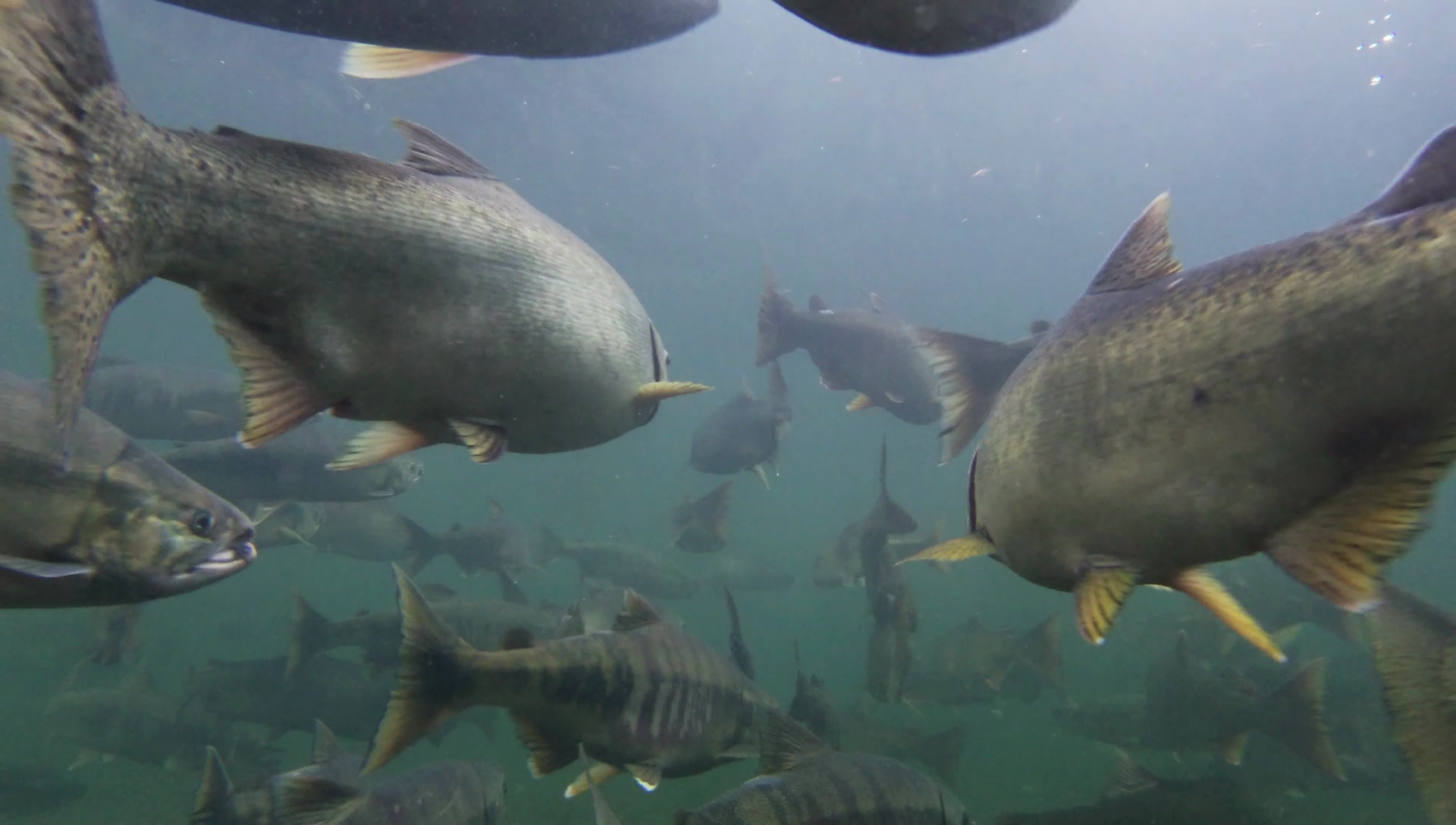Dive into the fascinating world beneath the surface of the waters as we explore the lifecycles of Coho, Chinook, and Chum Salmon, and Steelhead and Cutthroat Trout in this scientific expedition. From the mighty Chinook, the largest of Pacific Salmon, to the elusive Coastal Cutthroat Trout, each species reveals unique characteristics and plays a vital role in the intricacy of our local ecosystems.
Chinook Salmon
Oncorhynchus tshawytscha
The Chinook Salmon, also known as the Spring or King Salmon, commands attention as the largest among the Pacific Salmon species. With weights surpassing 100 pounds, these majestic fish journey from California to Alaska, leaving a distinct mark on the landscape. Explore their spawning habits, diverse migrations, and the integral role they play in the health of our oceans.

The largest of all the pacific Salmon species, the mighty Chinook Salmon may attain a weight of over 100 pounds! Spawning in large rivers from California to Alaska the Chinook average 18 to 24 pounds with up to 127 pounds recorded. Chinook have small black spots on the back, dorsal fin, and tail fin. The gums at the base of the teeth are gray. Fall run Chinook are robust and deep bodied, while spring Chinook are smaller and slimmer. They have a characteristic odor.
Fall Chinook spawn soon after arriving at their spawning grounds – usually in large rivers. The fry spend three to four months in fresh water. Spring Chinook migrate earlier, but delay spawning until fall, and they spawn in smaller tributaries. Their fry spend a year or more in fresh water. Their spawning age varies from two to seven years but most typically four. Chinook smolts will spend as little as a few weeks in fresh water to as long as one year!
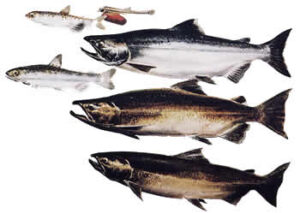

Chinook Salmon are known to migrate vast distances, and are found sparsely distributed across the Pacific Ocean from the Okhostk to the Bering Seas.
Take a look at some more informational images on Chinook salmon!

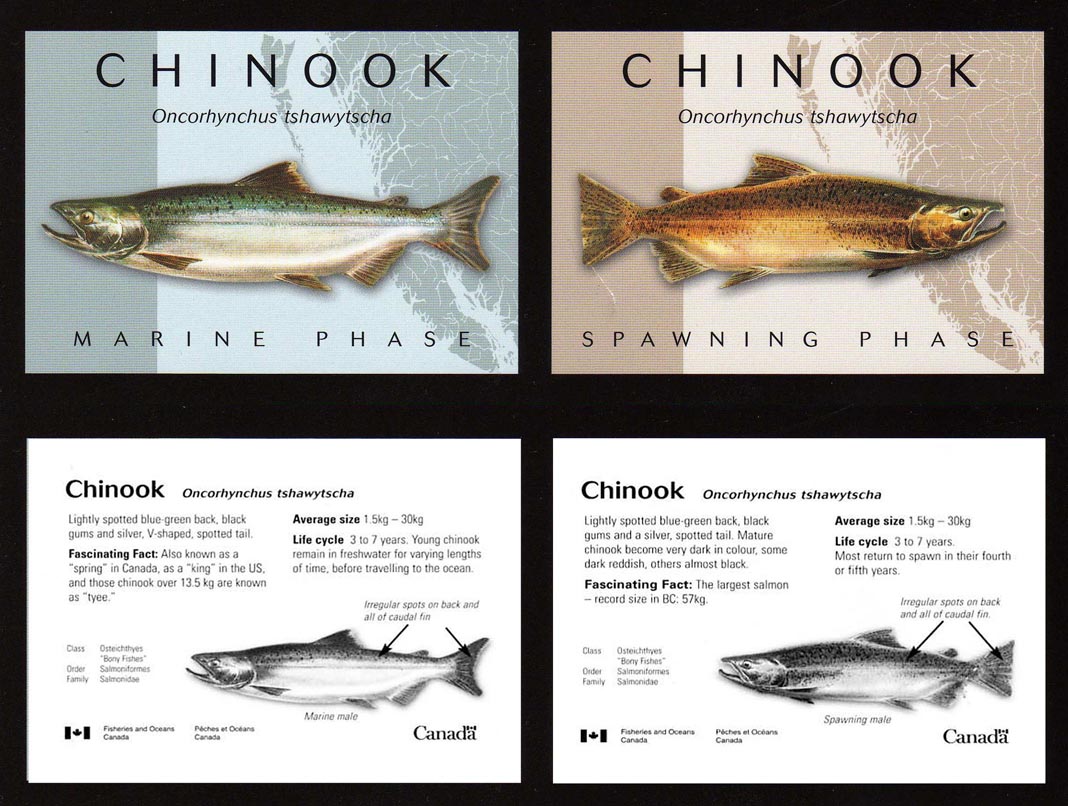
Coho Salmon
Oncorhynchus kisutch
Dive into the life of the Coho Salmon, also known as the Silver Salmon, as they navigate coastal streams in British Columbia. From their powerful leaps over falls to the vibrant transformations during spawning, Coho exhibit remarkable characteristics. Discover their migration patterns and the crucial role they play in maintaining a balanced marine ecosystem.

Coho spawn in over half the coastal 1500 streams in British Columbia. They migrate to sea after spending one to two years in freshwater, spending another 18 months to two years at sea. Coho generally return as mature adults after two years, those returning earlier are referred to as “Jacks”.
Coho salmon are powerfully built, and they can jump falls that most salmon cannot negotiate. They have small black spots on their backs and the upper lobe of the tail fin. The gums at the base of the teeth are white. Although sea run coho have silver sides, spawning males develop bright red sides and greenish backs. Spawning females are paler. The jaws of spawning males often become grotesquely hooked. Mature coho average 8-10 lbs. but it is not unusual to find fish exceeding 20 lbs. in Sooke waters.
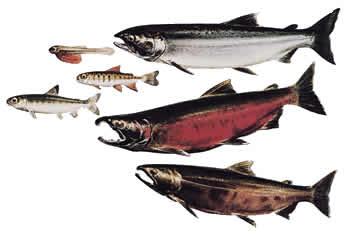
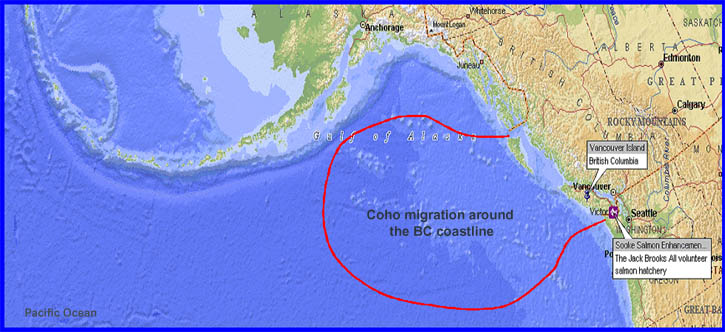
The Coho Salmon, shown on the map in red, move northward as juveniles staying approximately 40 km’s from shore. Mature Coho returning to their natal streams in the spring stay within 160 km’s from the North American coast line.
Take a look at some more informational images on Coho salmon!

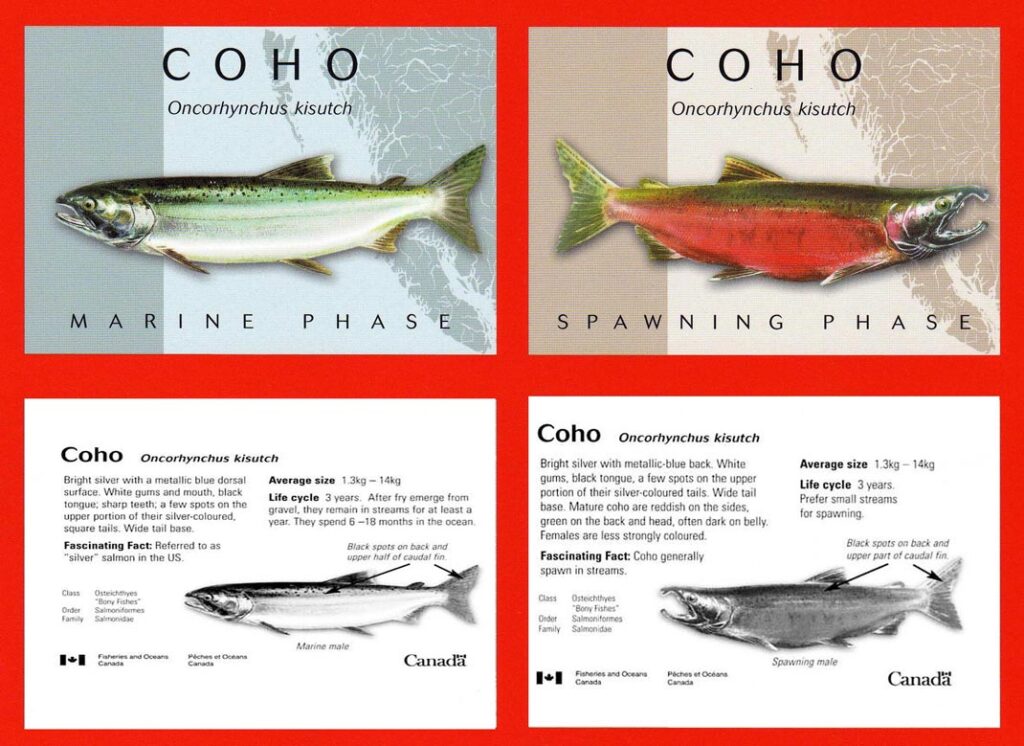
Chum Salmon
Oncorhynchus keta
Known as the Dog Salmon, Chum Salmon grace our coastal streams from Oregon to the Mackenzie River. Explore their unique features, spawning habits, and the challenges they face as they embark on a journey that spans both freshwater and the vast expanse of the North Pacific. Uncover the intricate balance of the Chum Salmon’s lifecycle.

Chum Salmon reproduce along the North American coast from Oregon to the Mackenzie river. Chum spawn in over 880 moderate sized coastal streams in British Columbia. Most Chum spend two to four summers at sea before returning to their streams of origin to spawn. Chum, also known as “dog” salmon from the large canine teeth of spawning males, are the second largest Pacific salmon, weighing up to 40 pounds. Spawning males develop reddish vertical bars on their flanks; females have a reddish lateral band. Although Chum are fast swimmers, they are not good jumpers, and they do not migrate far inland to spawn.
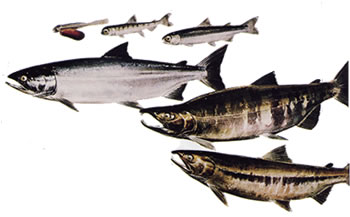
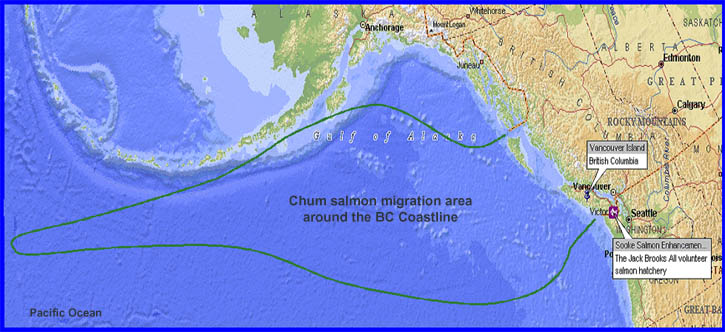
Chum fry migrate to the sea soon after they emerge from the gravel. They may spend up to 7 years at sea, but 4 years is typical. By their second summer in the Ocean. Chum Salmon are found throughout the Gulf of Alaska, North Pacific, and the Bering Sea. Chum originating in North America have been found as far West as 176°W in the North Pacific.
Take a look at some more informational images on Chum salmon!

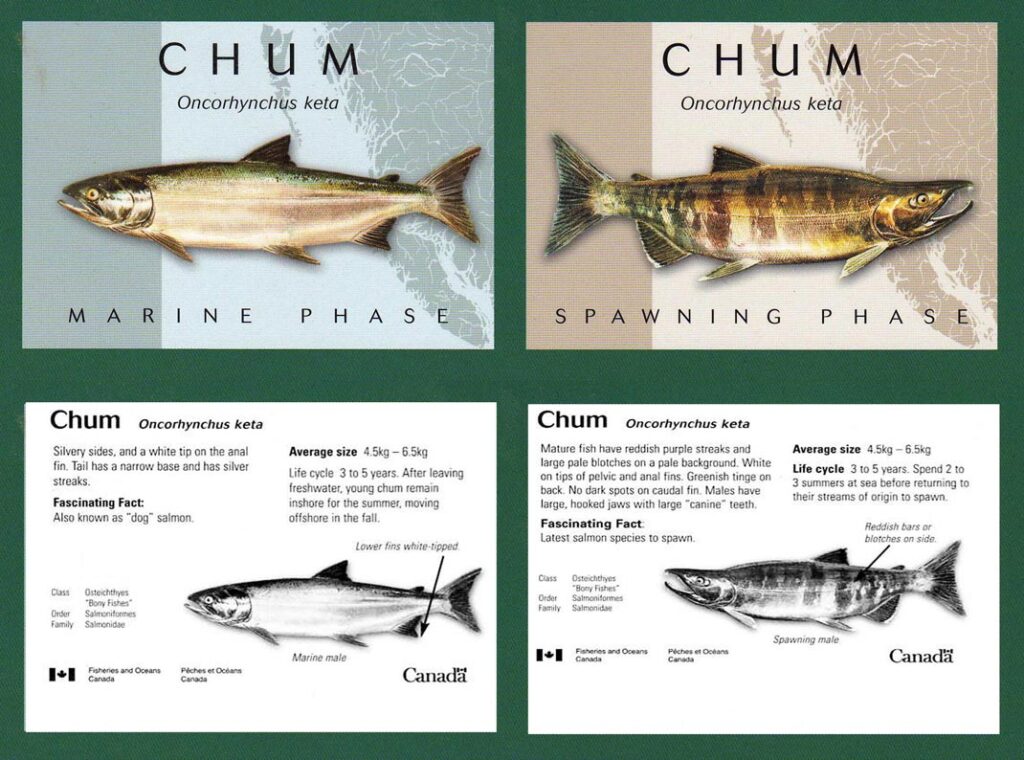
Bonus! Read More On Other Key Species on Vancouver Island
Steelhead Trout
Oncorhynchus mykiss
Delve into the world of Steelhead Trout, the resilient inhabitants of our rivers. Acting as indicators of stream health, these silver bullets exhibit diverse genetic runs and play a crucial role in the ecosystem. From their unique feeding habits to the fascinating variation in run timing, Steelhead provide insights into the well-being of our waterways.

Steelhead Trout are one of the greatest indicators of the health of a stream or river because they stay in the river longer than almost any other salmonid fish. The presence of Steelhead in any river system tells us that there is hope for the future of the stream. If it’s good enough for the Steelhead it is pretty much good enough for all fish.
Steelhead follow salmon into the river and if you know when the salmon in any given river are moving to spawn you can rest assured that there are a few steelhead in their wake. If one looks carefully enough at a school of pre-spawning Salmon look behind the school and you might see a steely coloured fish or gray ghost lying behind waiting to eat some stray eggs. This is why anglers use Salmon Roe and other egg imitations when angling for Steelhead. The silvery ghosts feed on the eggs of all other fish in the river and on their own as well.
If salmon are in decline in any river system the steelhead will be in peril. If it wasn’t for our hatchery it is likely that the Sooke River System would have little or no steelhead at all. We also capture Steelhead for brood stock and actively enhance the river with thousands of smolts every year.
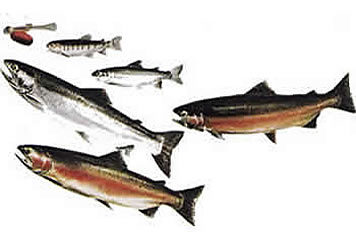
One of the most interesting aspects of Steelhead is that they are very genetically diverse meaning that there are numerous little runs of fish moving into the river at all different times of the year. What is even more interesting is that the higher the latitude of the river location the more variation in run timing.
Here in Sooke (48.5 N latitude) Steelhead begin to arrive in late summer with the Chinook Salmon and then filter in right through until March. There are two distinct runs of Steelhead: the Summer Run fish which typically show up prior to mid December and is usually smaller; and the larger Winter Run Steelhead.
The Summer Run fish usually spawn a little before the Winter Run fish but even this can vary. In some cases they spawn at the same time – usually March or April. The greatest thing about Steelhead is that once they have spawned they do not die but they actually go on a feeding frenzy that revitalizes their bright silvery scales to a bumper chrome finish. We call this action mending and the term for Steelhead returning downstream is “Kelt.” Watch out for the “Keltic Steelhead” as they are voracious feeders and have insatiable appetite for almost anything that they can find!
In addition to the Sooke, other river systems in Canada known for large Steelhead are Cowichan River, Gold River, Yacoun River, Dean River and the Thompson River. The numbers of large specimens has been in recession for some time due to environmental damage, poor ocean survival, and over fishing.
Description: The average length of steelhead is 20-30 inches. A typical mature steelhead usually weighs 8-12 pounds but has been known to reach 36 pounds. The body resembles a silver bullet when fresh in from the ocean and has a rounded snout and a large mouth. The spawning male experiences minor changes to its head, mouth and colour gaining red sides. Females tend to be more silvery. All have a number of small black spots. The colouring varies drastically over the whole of its range.

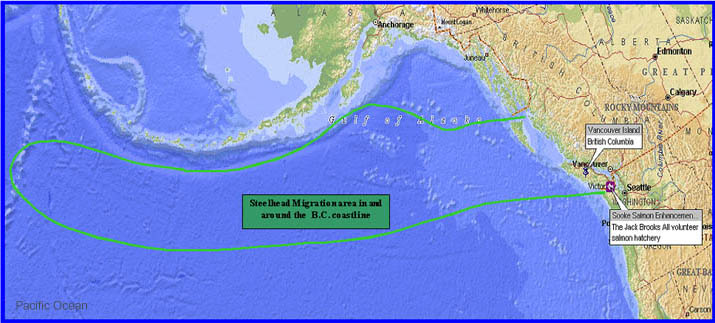
Location: The native range of this species is the northern coasts Pacific Ocean and the fresh water mainly west of the Rocky Mountains and across the Kamchatka Peninsula in Russia. It has also been successfully introduced into the Canadian Great Lakes and into New Zealand, Chile, Argentina, Africa, Japan, southern Asia, Europe and Hawaii.
*The BC Provincial Steelhead program was shut down in 2011 after 6 years of participation by the Sooke Salmon Enhancement Society.
Cutthroat Trout
Oncorhynchus clarkii
Discover the lesser-known Coastal Cutthroat Trout, both sea-run and resident, residing in our rivers and lakes. While the sea-run Cutthroat showcases a mesmerizing bluish-silver hue, the resident variety demonstrates remarkable resilience in challenging environments. Unravel the mysteries surrounding these elusive and adaptive trout species.
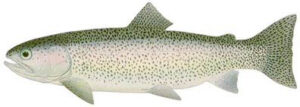
Coastal Cutthroat Trout are likely the least studied and as a result the least understood of all Pacific Salmonids. They are little known simply because they are not a source of income for any specific interest group, hence they don’t get a lot of funding for research directed toward learning more about them. Like Steelhead there are two different groups of Cutthroat Trout. They are known as Resident (Potadromous, remaining in fresh water) and non-resident (Anadromous or Sea Run). Both types may co-exist in the same river system which makes studying them even more challenging.
Sea-run cutthroat remain for three to four years in fresh water and migrate to sea during May when they are about 8 inches long. Identification of the Sea Run Cutthroat can sometimes be easier as they tend to bluish-silver with dark or olive backs but their characteristic slash under the jaw can sometimes be just faint yellow. Many times these sea-faring fish are bumper chrome when in the estuary or ocean and arguably are the most unique and most beautiful fish around.
Resident coastal cutthroat remain in fresh water after hatching and live in streams, beaver ponds, sloughs, and lakes. In lakes, smaller cutthroat hide among lily pads, sunken logs, or rubble from which they dart out and seize insects and small fish. Resident Cutthroat such as those found in large coastal lakes can exceed 10 pounds. The lack of food in our coastal lakes and their sometimes enormous size makes these fish remarkable survivors sometimes over 12 years of age.
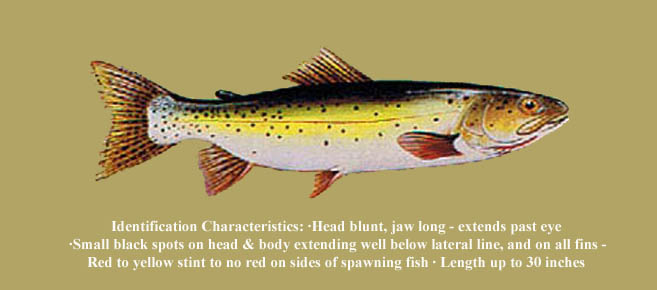
The Cutthroat have proven their ability to be resilient and have survived through almost everything that man has imposed upon them. They can be found cruising in Victoria’s Inner Harbour and also in great numbers in our own Sooke Basin. Legend has it that there are Sea Run Cuttys in Sooke to 8 pounds which is by any standard trophy size. No doubt they feed on lots of fry released from Sooke Salmon Enhancement Society’s enhancement program!
Vancouver Island Black Bears
Ursus americanus vancouveri
Welcome to the realm of the Vancouver Island Black Bears. Flourishing along the bountiful coast of British Columbia, these majestic creatures find their rhythm in the ebb and flow of salmon-bearing rivers and streams. As nature’s omnivores, they patiently await the return of salmon, sustaining themselves on berries and vegetation until their aquatic feast arrives.
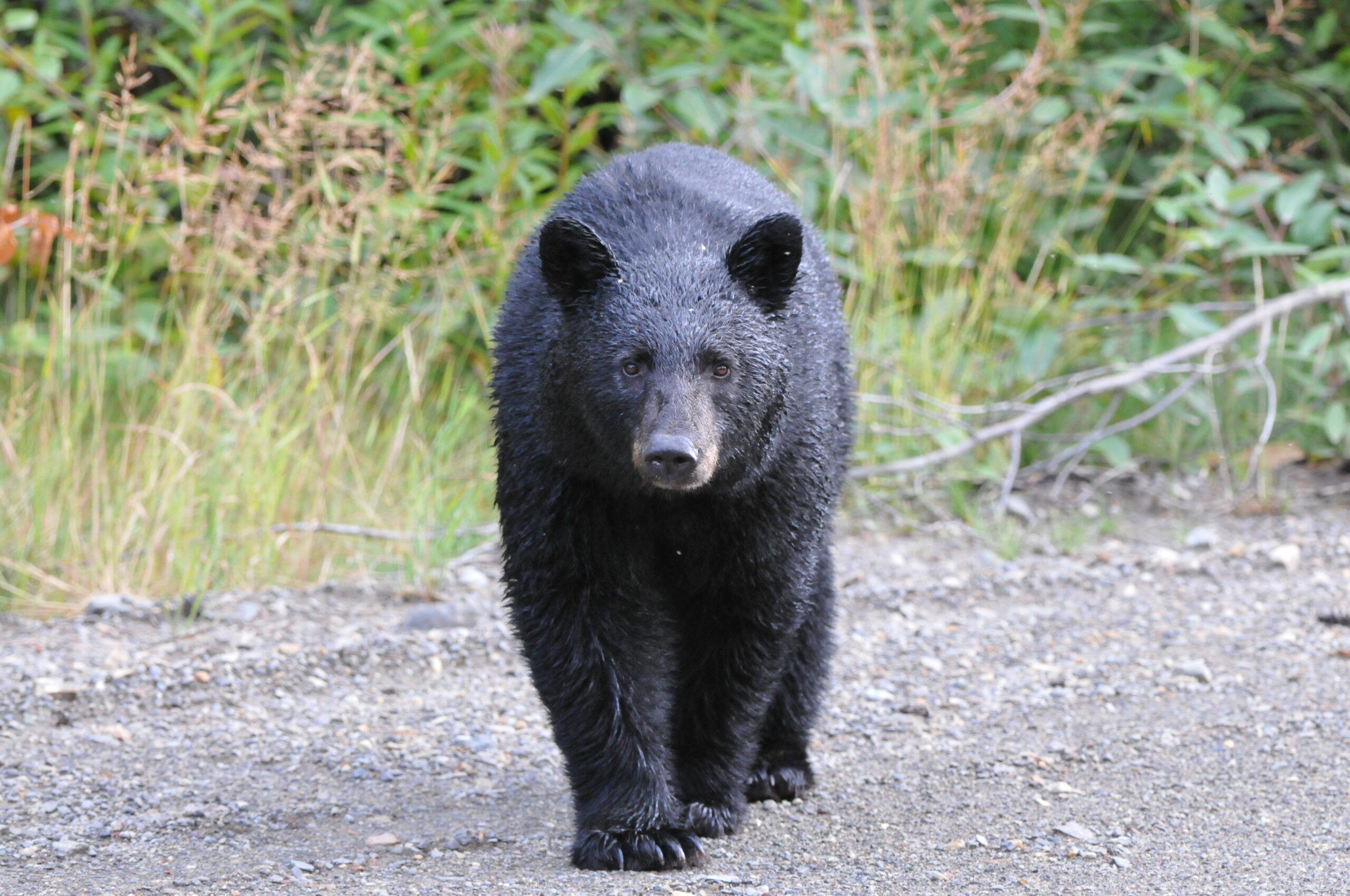
Black Bears flourish on the coast of British Columbia in large part due to the numerous salmon bearing rivers and streams. The Black Bear awaits the salmon’s return. Until then their primary diet consists of berries and vegetation. They are omnivores meaning that they feed on pretty much anything.
Coastal Black Bears of BC are known around the world for their beauty and their size. The black bear is four to seven feet from nose to tail, two to three feet high at the shoulders and can weigh in excess of 500 pounds. It has small eyes, rounded ears, a long snout, a large body, a short tail, and shaggy hair. It differs from grizzly bears in being smaller with a smaller shoulder hump, a furred rear instep, a less concave facial profile, smaller claws that are more tightly curved, and longer, smoother and more tapered ears.
By eating salmon, bears play an integral part in the growth of massive Douglas Firs, Sitka Spruce, and Western Red Cedar that line our rivers and streams. They catch the fish and drag them into the forest. The partially eaten salmon carcasses act as fertilizer that aids in growth of the coastal forest.
Don’t be surprised in the fall to see one of these black beauties along the banks of the Sooke River dragging some returning Salmon into the forest!
Here are some additional facts about black bears:
- Names: Some black bear subspecies go by different names, like Kermode bear, Cinnamon bear, or Glacier bear, but they are all black bears. Sometimes male and female bears are called boars and sows.
- Range: The American Black Bear is found only in North America where it is widespread. The population is estimated at 750,000. They live in forests as far south as Florida and northern Mexico and as far north as forests grow in Alaska and Canada
- Adult Length: 50 to 80 inches long, nose to tail, with males being larger than females.
- Mating Season: Usually from late May to early July. In the eastern deciduous forest, the mating season can extend into August.
- Implantation: Delayed until November.
- Birth: January or early February.
- Number of Cubs: The number of cubs in a litter is usually two in the West and three in the East. First litters are often only one or two with up to 6 reported in several eastern states. Litter size is dependent on caloric intake of females.
- Birth Weight: Cubs weigh 1/2 to 1 pound at birth.


